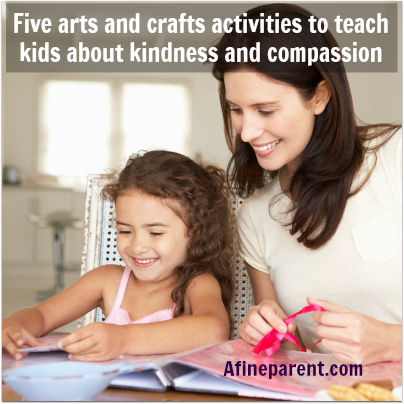 Kids are naturally selfish – me, me, me and mine, mine, mine. Not surprising: in the early months and years, it is all about them. So how do we teach our kids to think of others and to treat other people with kindness and compassion?
Kids are naturally selfish – me, me, me and mine, mine, mine. Not surprising: in the early months and years, it is all about them. So how do we teach our kids to think of others and to treat other people with kindness and compassion?
Kindness and compassion are rooted in empathy and stem from the golden rule of treating others how we wish to be treated ourselves.
Some days, though, I can spout the golden rule ‘til the cows come home and yet it feels like it never sinks in. You encourage compassion, you support acts of kindness, and you try your best to demonstrate empathy, and yet five minutes later the kids are arguing over who sets the table more often and wrestling over the Xbox controllers.
“Be nice to your sister!” you say. “Don’t talk that way to your brother!”
“Blah, blah, blah,” is what they hear.
Once, when they were younger, my daughter broke a plastic ladle over my son’s head. They’d been playing nicely in the other room when the wailing began. Between reprimanding the one and consoling the other and trying to get to the root of the problem (“he was mean!” “no, she was!”) we were all finally reduced to tears. (There should be a course in complex mediation skills for all parents, but that’s a whole other topic…)
Anyway, that morning we spent some time talking and processing the emotions: how did it make you feel when he did that? Was hitting the proper response? How would you feel if someone did that to you?
Kindness can be taught. From their earliest days, kids learn by seeing and copying the people around them. Kids can learn kindness by watching and doing. We can lecture our kids about kindness until we’re blue in the face, but practicing kindness has a far greater impact than simply talking about it.
Art and craft activities that have kindness and compassion at their root are fantastic to get kids thinking about kindness and compassion and making concrete steps in that direction.
Below are five kindness activities for kids that encourage them to spread kindness and act with compassion.
#1: Random Acts of Kindness Presents
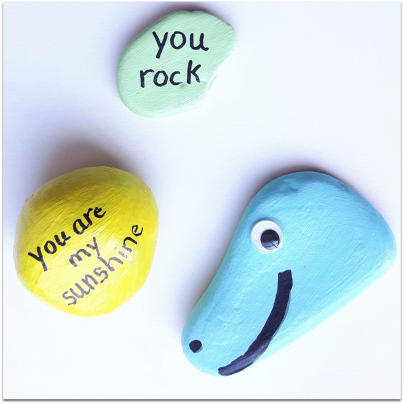 Asking kids to be randomly kind is like asking them to clean their rooms “when they get a chance.” Not going to happen. Sitting down to make a fun craft specifically for someone for no particular reason, however, gives kindness a subtle direction, and makes the giver feel great.
Asking kids to be randomly kind is like asking them to clean their rooms “when they get a chance.” Not going to happen. Sitting down to make a fun craft specifically for someone for no particular reason, however, gives kindness a subtle direction, and makes the giver feel great.
Two great projects for random acts of kindness presents are pet rocks and paperweights and bookmarks.
What you need: rocks; acrylic paint; paper; scissors; pencils, crayons, or markers; googly eyes; stick-on gems.
What to do:
- For pet rocks and paperweights:
- Find nice smooth rocks. This can involve a fun trip to the beach, the park, or your local building supply store.
- Paint the rock. This will involve some drying time, but you can also leave the rocks in their natural state and write on them with a marker if you are short on time.
- Attach googly eyes if making a pet rock. If you are making a paperweight, decorate the rock with stick-on gems and write messages: ‘I love you,’ ‘You are beautiful,’ ‘You make me smile,’ ‘I love your laughter,’ ‘You are fun!’
- Give the rock to a neighbor or friend. Or, treat them as kindness rocks that you hide around neighborhoods, stores, schools, and other places for people to find! There’s no greater feeling that knowing you have added some positivity in the life of a complete stranger.
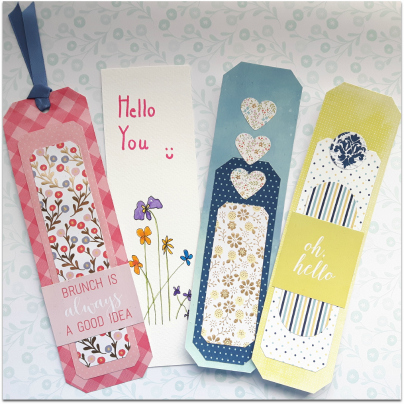
- For bookmarks:
- Cut paper into strips. 2” x 8” is a great size for bookmarks.
- Decorate the bookmarks with pictures or messages as shown.
- While you are making the present, talk about the person you’re going to give it to. A grandmother who reads a lot, maybe, or a favorite neighbor.
#2: Random Acts of Kindness Bingo
 Kids understand the concept of being kind, but sometimes they have difficulty knowing how to put the concept into action. Play this ongoing game around the house so they have easy options at hand all the time.
Kids understand the concept of being kind, but sometimes they have difficulty knowing how to put the concept into action. Play this ongoing game around the house so they have easy options at hand all the time.
What you need: paper, pencils, crayons or markers; bingo stampers or highlighters.
What to do:
- Make a grid on a piece of paper. Make as many squares as you wish but sixteen or twenty-five work well. For very small children, nine squares help to achieve a “Bingo” a little more quickly.
- The kids can decorate the Bingo sheet with images that come to mind when they think about kindness (hearts, rainbows, helping hands).
- In each Bingo square, write an act of kindness. Get your kids involved and encourage them to think up ways to be kind: say hi to a neighbor down the street, help younger sibling pour the milk, set the table without being asked, etc. Leave a square or two blanks for spontaneous acts of kindness that aren’t specified on the Bingo sheet.
- Make, decorate and cut out small hearts. Then, stick the hearts to the bingo board when the kids complete the acts of kindness. You could also stamp the square with a Bingo stamper or highlight it if you prefer.
- When the Bingo square is complete have some way to celebrate: a special dessert, or a half-hour later bedtime, for example.
# 3: Paper Chain of Kindness
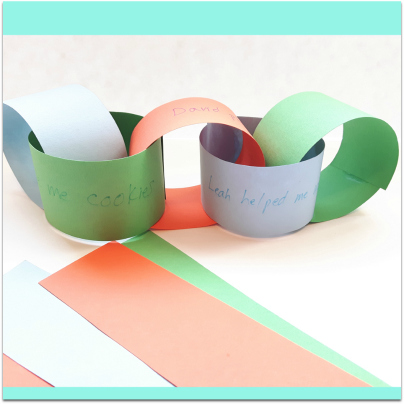 This is a great idea from the blog Sugar Spice and Glitter.
This is a great idea from the blog Sugar Spice and Glitter.
This craft is fabulous for encouraging kids to reflect on the kind things people have done for them and to make them think of the kind things they can do for others. It’s a lovely way to encourage kids to think about paying it forward.
What you need: construction paper; pencils, crayons or markers; scissors, glue or tape.
What to do:
- Cut colorful construction paper into strips. Have a pile of strips ready and waiting.
- Encourage your kids to think about times when someone has been kind to them: when a sibling shared a toy, when the babysitter brought them some candy.
- Have the kids write (or help the younger ones write) the act of kindness on a strip of paper, and then bend it into a circle and tape or glue. Take the second one and loop it through the first and tape or glue, eventually making a long chain.
- Subtly (or not so!) remind your kids that the kind acts they perform can be added to the chain.
- Make it a challenge to see how long the chain can be.
#4: A Long Distance Hug
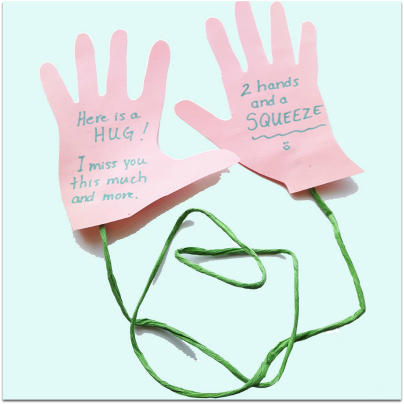 If someone you know is going through a hard time, whether they’ve lost a family member or a pet, or are dealing with an illness, sending a long distance hug is a great way to talk to your kids about what the person is dealing with and emphasize how kindness can make others feel better. This is a great way to encourage thoughts of kindness toward friends and family far away, or even someone in the same city who might need a hug.
If someone you know is going through a hard time, whether they’ve lost a family member or a pet, or are dealing with an illness, sending a long distance hug is a great way to talk to your kids about what the person is dealing with and emphasize how kindness can make others feel better. This is a great way to encourage thoughts of kindness toward friends and family far away, or even someone in the same city who might need a hug.
What you need: construction paper; crayons or markers; yarn or string; glue; scissors. Envelopes and stamps.
What to do:
- Have the kids trace their hands and cut out the shapes.
- Cut a length of string or yarn and glue one end to each hand cut-out.
- Write a message on each hand, or decorate the hands. A add a small card telling the recipient that they are receiving a long distance hug.
- Mail the hug.
#5: Kindness in the Mail
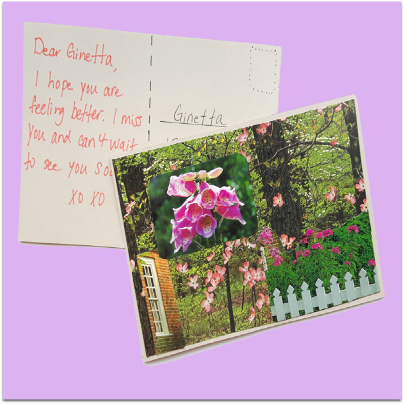 With email, text, Skype, and FaceTime, it is rare that people receive anything other than flyers and bills in the mail. This is a great craft to encourage kids to connect to loved ones who live far away, to send them kind thoughts, and to foster positive good feelings towards others.
With email, text, Skype, and FaceTime, it is rare that people receive anything other than flyers and bills in the mail. This is a great craft to encourage kids to connect to loved ones who live far away, to send them kind thoughts, and to foster positive good feelings towards others.
What you need: card stock or thick paper or blank postcards; pencils, crayons or markers. Stamps.
What to do:
- Cut thick paper or cardstock into rectangles. The standard size for postcards is A6 size, 148 x 105 mm, or 5.8 x 4.1 inches. (However, a 4×6” card is not going to be rejected.)
- Decorate one side of the postcard with a picture or words or collage.
- Draw a line down the middle of the back of the paper, write the address of the recipient on the right side, and add a message on the left side. Messages can be: thinking of you! Or Can’t wait to see you soon! Or Remember when we caught that fish last summer… Emphasize messages of kindness and good feelings.
- Mail the postcards to cousins, aunts and uncles, grandparents and long-distance friends.
Teaching our kids to be kind and compassionate sometimes feels like an uphill battle, but taking the time to create something that reflects kind thoughts helps to embed a little compassion into our busy, self-centered lives. I hope you found this list of kindness activities for kids useful!
2-Minute Action Plan for Fine Parents
- Arts and crafts don’t have to take up a lot of time. Find half an hour in your weekly schedule, write it in your calendar and commit to it. You’ll find you start looking forward to that time.
- Pick one of the crafts described above, or choose your own.
- Use daily news or life events to talk about kindness, and involve the kids in discussions about what you can do or make to help spread kindness and compassion.
- Try loving kindness meditation.
Ongoing Action Plan for Fine Parents
- Make craft time a recurring fun time – the crafts don’t always have to be about kindness – art for art sake is always an excellent idea.
- Encourage kids to come up with other things to make for people
- Be a role model! Kids learn by example. The more kindness and compassion we show in our words and actions, the more it rubs off on the kids. We could all send more thank you cards and practice random acts of kindness!
Thanks for these wonderful ideas! I love that they are simple but meaningful, the best combination.
Thanks Gina – I’m so glad you liked them.
Sometimes the best way to teach your child not to give up is to let him do what he wants. I mean let him to chose the way to develope.
Hi Brenny, thanks for your comment!
This is a fabulous approach to raising kind kids! This creative approach is a wonderful addition to any parent’s toolbox.
I’ve been teaching kindness for years, but will definitely draw attention to your work in future, Leslie. Thank you!!
Thanks Anne!